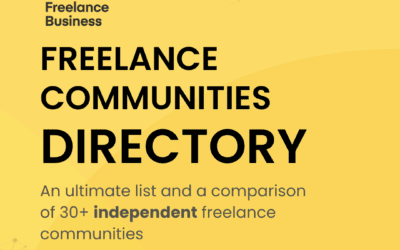In 2020, Tom wrote a Twitter post sharing his experience pricing freelance projects. Over the next 36 hours, it had gained tens of thousands of likes. This inspired him to expand the post to a full book on pricing which he published, called Pricing Freelance Projects.
We invited Tom to share his knowledge on pricing for freelancers and asked him about hot topic like picking the best pricing strategy, choosing hourly vs project billing, using retainers, and more. Here’s what we learned from his masterclass.
Tom has been freelancing for more than 10 years and we first asked him
What has contributed to his success and what it takes to build a great personal brand?
For Tom, one of the main routes for building a strong personal brand is to just stick around. Consistency brings credibility and trust, so the longer you are practising your craft, the better you will be perceived by clients.
Of course, not everyone can start freelancing with 10 years of experience under their belt, so the other piece of the puzzle for Tom is to be perceived as one of the best in what you do. He advises to narrow down your area of focus, which will allow you to build your experience much quicker than if you are a generalist.
To help his business grow, he also focused on optimisation. He introduced systems and repeated processes which automated small processes and helped with marketing and administration.
We wondered:
Where does his well of knowledge on pricing comes from?
He started like all great entrepreneurs – by selling Pokemon cards in his youth. This made him interested in value and worth, as some cards have insane value and go for thousands of dollars. When he actually began freelancing, he wanted not only to be a good developer, but a good business person too. He turned to business books to feed his curiosity and read many books on pricing. On top of that, due to his long experience as a freelancers, he had plenty of opportunities to experiment and see how different pricing methodologies fit certain criteria. For him, education plus feedback from trying new things was the winning formula which gave him the confidence to write his own book.
Where do you start when approaching pricing as a freelancer?
For Tom, the problem with pricing for freelancers is that people tend to look for a one-size-fits-all solution, which simply does not exist. What you need to do is look at pricing with greater depth. It is not a simple topic.
In most cases, price will be informed by several factors, such as is who the client is, what your level of expertise is, how much competition do you face and what is its skill level, what the project is itself and more. If all that feels too overwhelming, Tom advises you to first focus on the value you add to a project, rather than the labour that you provide, and use that to inform your prices.
What should you base your project price on?
Once you have experience, Tom shared, you start to predict how difficult projects will be, how long they will take and how good you are at delivering results. As time goes on, you get more valuable as you improve your skills, so it is a good idea to use previous prices as a base point and add on top of that.
You may want to benchmark your prices with the other freelancers in your field. Tom stresses that pricing is quite personal and value is subjective, so it may not be the best approach to directly compare rates. However, having a network and knowing what your collaborators and competitors charge is very helpful.
Finally, don’t be afraid to experiment with you price and try new things!
You can also see Helen Dibble’s talk on Hacks and formulas for pricing your projects here and Peter Janssens’s session on Pricing your expertise!
When is the time to raise prices?
You will get a good idea about it when you talk to others. If you feel like the compensation you’re receiving isn’t in line with what you are providing, then you should consider raising prices. Also, when you work with clients and find yourselves fully booked (i.e. the demand for your skills is outpacing the supply), then you should raise your prices.
How to increase your value?
What if you want to increase you value (and your price)? Tom advised us to get in the client’s’ shoes. What is the thought process they are going through? Value is personal – are what you offer and what they need in alignment?
A great way to increase your value would be to develop your crossover skills. For example, if you are a developer, you can highlight your marketing skills. A client will usually value a developer who can also write copy for the website or help with the design more than a freelancer who can only develop.
One underestimated element are your soft skills. Being nice, communicative and easy to work with can go a long way in making clients perceive you as more valuable. In the end of the day, you are a person. Tell your story, use your personality.
A bold claim of his is that hourly – billing is the worst pricing methodology. Why?
Tom said that you may not have enough leverage to choose your methodology with the client, so in the start you might be forced to use hourly rates. The problem with continuing to use that approach is that you’re imposing an income ceiling on yourself. One solution is to work more hours, but then you will meet a natural time ceiling, as there is a limited number of hours per week. The other solution is that you can increase your hourly price, but this may lead to a loss of clients: current clients are used to paying the lower rate and they might not like you increasing it, while new clients may be turned off by your higher entry rate – there are often market rate anchors, indicating rates people won’t go over. Plus, hourly work comes with the need to do hourly billing, which can be time consuming. He recommended a book on the topic: Hourly Billing Is Nuts by Jonathan Stark.
What other pricing strategies would he recommend?
He advised us to that your goal should be to move to project pricing, as it makes your work easier. Not everyone can do that at the start, but it should be one of your goals as you grow your freelance business.
We discussed the Day rate as well. Tom shared that it can be a good rate, as long as it is for a day’s work, not 8 hours. Let’s say one day you’d like to work for 6 hours, the next for 10. You need to know you are getting the same rate for both days.
In conclusion, he would advice all freelancers to move away from methodologies that are selling direct units of their time.
What about Value – based pricing?
Tom says it is more complicated and requires time. What you should do is define results you can give – X amount of time saved, Y amount of leads gathered. Tie the work you’re doing to a tangible result. If you can visualise the value you are adding in the client’s mind, you can justify the price you are charging. Say you see that a client is paying £50 ppc for 1 lead. If you think you can redesign their landing page and get them 10 leads, there’s a 500 pound value in that. Convince them you can be useful.
Hear more amazing tips on using value-based pricing with Marie Rachelle’s session: Earn your worth: value based pricing!
Should you compromise on your pricing if you really want to land a specific client?
The reality is we all find work we really want to do – it may be because of the experience we will get, because of what we can learn from the client, or even just for the paycheck. In these situations, you may want to price yourself a bit lower, as you will get added value further down the line. Tom approaches these situations differently – he claims he never negotiates on price, but rather on the terms of the project. Let’s say he’ll wish for a more flexible schedule, or some of the payment upfront, rather than haggle on the price.
Should your put your prices on you website or LinedIn?
For him it depends. If you offer a standardised product or service in which the clients know what they get, then putting your price out there can make it easier for people to close deals quicker. For bespoke or specific project though, it is impossible to give the price upfront.
If the client wants you to do maintenance on the project after it has been delivered, how do you price that?
Tom advices us to communicate in the beginning if maintenance is work you’d like to do. If you’d be happy to do work after the end of the project, get a retainer agreement. Now, a retainer agreement might seem obvious for developers and similar IT freelancers, but what if you are a writer or a marketer? Tom shared that you can still benefit from using a retainer. For example, if you have a client with an ongoing need for content, you can say that you will deliver X amount of articles for Y amount of money per month. If you agree on that as an ongoing agreement, that can be more efficient than pitching for individual articles.
How to handle pricing in partnerships?
Although Tom worked solo for most of his career, when tasks can be easily separated, he likes to onboard other people. If he develops, he can get a designer or a copywriter to help him. When doing that, he asks for a fixed price from his sub-contractor, so everyone knows what they are getting. This helps him know if the project will be financially viable.
Should you have different prices for an individual vs a business?
Tom keeps it the same. He wouldn’t make his price cheeper if it’s a 1 or a 10 person business. You shouldn’t look at size but the value you can add.
What about client red flags?
Tom shard: If someone is concerned only about price or time, rather than how you do your job or what value you can offer, that is a bad sign. In cases like these, he advises you to secure a deposit before you start work: No-one is fully committed to a project until they’re paid some money.
What is the process of creating a book and getting it published?
Finally, we asked him about his two books. Tom shared his first book, 10 Steps to Becoming a Better Freelancer, was more of an experiment to see if he could write a book. This is why he distributed it for free, to act as a lead magnet, and spend only 6-7 weeks on it. His 2nd book came about through chance, as a tweet on pricing went viral. He then dropped everything and wrote a book for a month, as he saw there was a thirst for this kind of knowledge.
He shared this move towards providing digital products is part of his transition to a passive income. He advised us to build an audience and help people, and through that build a passive income stream and scale it. Not everyone can write a book – if it’s difficult for you, make a guide or do a paid email list. Think about diversification, as you may not want to work hard as a freelancer all your life. If you want to sell a product, make sure you have an audience for it. If you don’t have one yet, start attracting the attention of people who might buy your product. What he did was tweet about freelancing, and that way he attracted an audience and released people are interested in what he has to say.
Finally, don’t forget to dedicate time to marketing even when you are busy – that’s how you build a pipeline of work.
Hear more expert advice on pricing with Robert Vlach’s helpful session on Financial self-management.
Tom shared much more helpful insights about pricing and freelancing during our masterclass. You can see it in full here or you can get in touch with Tom on his website and LinkedIn.




